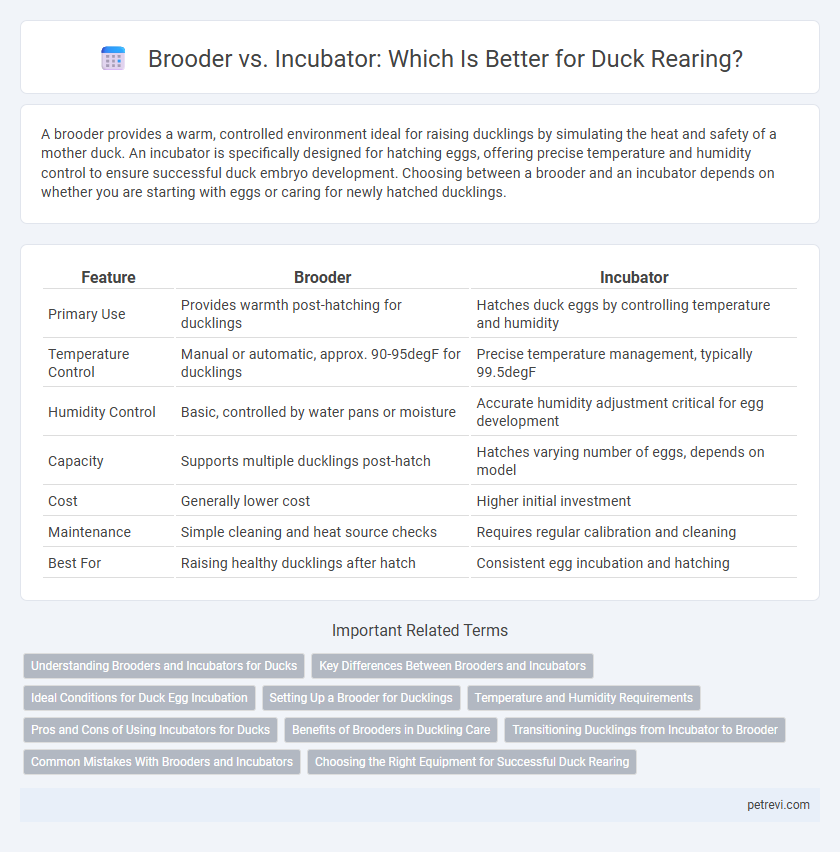A brooder provides a warm, controlled environment ideal for raising ducklings by simulating the heat and safety of a mother duck. An incubator is specifically designed for hatching eggs, offering precise temperature and humidity control to ensure successful duck embryo development. Choosing between a brooder and an incubator depends on whether you are starting with eggs or caring for newly hatched ducklings.
Table of Comparison
| Feature | Brooder | Incubator |
|---|---|---|
| Primary Use | Provides warmth post-hatching for ducklings | Hatches duck eggs by controlling temperature and humidity |
| Temperature Control | Manual or automatic, approx. 90-95degF for ducklings | Precise temperature management, typically 99.5degF |
| Humidity Control | Basic, controlled by water pans or moisture | Accurate humidity adjustment critical for egg development |
| Capacity | Supports multiple ducklings post-hatch | Hatches varying number of eggs, depends on model |
| Cost | Generally lower cost | Higher initial investment |
| Maintenance | Simple cleaning and heat source checks | Requires regular calibration and cleaning |
| Best For | Raising healthy ducklings after hatch | Consistent egg incubation and hatching |
Understanding Brooders and Incubators for Ducks
Brooders provide a controlled warm environment essential for newly hatched ducklings, ensuring optimal temperature and comfort during their early development stages. Incubators maintain precise humidity and temperature controls necessary for successful egg incubation, promoting high hatch rates and healthy embryo growth. Selecting the right equipment depends on whether the focus is on hatching eggs or nurturing ducklings post-hatch, both critical for effective duck rearing.
Key Differences Between Brooders and Incubators
Brooders provide a controlled heat source to keep newly hatched ducklings warm and promote healthy early growth, while incubators are designed to maintain optimal temperature and humidity levels for proper egg incubation until hatching. Brooders typically feature heating lamps or plates and are used post-hatch, whereas incubators automate turning and precise environmental control during the embryonic development phase. Understanding these distinctions ensures better survival rates and healthier ducklings throughout the rearing process.
Ideal Conditions for Duck Egg Incubation
Optimal duck egg incubation requires maintaining a consistent temperature of 99.5degF (37.5degC) and humidity levels around 55% for the first 25 days, increasing to 65-70% during the final three days before hatching. A brooder offers natural warmth and airflow but can fluctuate in temperature, whereas an incubator provides precise control over environmental conditions to ensure higher hatch rates. Proper ventilation, regular turning of eggs, and stable conditions are crucial for maximizing embryo development and preventing mortality.
Setting Up a Brooder for Ducklings
Setting up a brooder for ducklings requires maintaining a temperature of 90-95degF during the first week, gradually decreasing by 5degF each week until fully feathered. Provide a heat source such as a heat lamp positioned safely to prevent burns, and ensure the brooder is spacious with clean, dry bedding like straw or wood shavings. Include a shallow water dish to prevent drowning and easy access to food formulated specifically for ducklings to support healthy growth.
Temperature and Humidity Requirements
Brooders for duck rearing maintain a stable temperature of around 90degF (32degC) during the first week, gradually decreasing by 5degF each week, with humidity levels between 50-60% to prevent respiratory issues. Incubators require precise control at 99.5degF (37.5degC) and humidity levels around 55-60% for successful egg hatching. Ensuring optimal temperature and humidity in both brooders and incubators is crucial for healthy duckling development and survival rates.
Pros and Cons of Using Incubators for Ducks
Incubators provide a controlled environment with consistent temperature and humidity, improving hatch rates and minimizing the risk of egg loss due to external factors. However, they require an initial investment in equipment and continuous monitoring to prevent overheating or drying out, which can affect embryo development. Unlike brooders, incubators lack the natural warmth and care provided by a mother duck, potentially impacting the early health and behavior of ducklings.
Benefits of Brooders in Duckling Care
Brooders provide a controlled, warm environment essential for duckling development, mimicking natural maternal warmth and preventing hypothermia. Their design allows for easy access to heat and food sources, promoting healthy growth and reducing stress compared to incubators. The use of brooders enhances survival rates by maintaining optimal temperature and humidity, critical factors in early duckling care.
Transitioning Ducklings from Incubator to Brooder
Transitioning ducklings from an incubator to a brooder requires maintaining optimal temperature and humidity levels to ensure proper development and health. Ducklings thrive when the brooder temperature starts around 90degF (32degC) and gradually decreases by 5degF weekly until fully feathered. Providing ample space, clean water, and nutritious feed during this transition supports strong growth and minimizes stress.
Common Mistakes With Brooders and Incubators
Common mistakes with brooders include insufficient temperature control and inadequate ventilation, which can lead to overheating or chilling of ducklings, significantly affecting their survival rates. In incubators, errors such as improper egg turning frequency and incorrect humidity levels often result in poor hatchability and deformities in ducklings. Ensuring precise temperature management, proper humidity settings, and regular monitoring are critical to optimizing both brooder and incubator performance for successful duck rearing.
Choosing the Right Equipment for Successful Duck Rearing
Selecting between a brooder and an incubator is crucial for successful duck rearing, as brooders provide controlled warmth and space for ducklings post-hatch, while incubators ensure optimal temperature and humidity for egg development. Brooders enhance survival rates by mimicking natural conditions, preventing chilling and promoting healthy growth. Incubators with precise temperature controls and humidity settings increase hatchability and reduce embryo mortality in duck egg incubation.
Brooder vs Incubator for Duck Rearing Infographic

 petrevi.com
petrevi.com